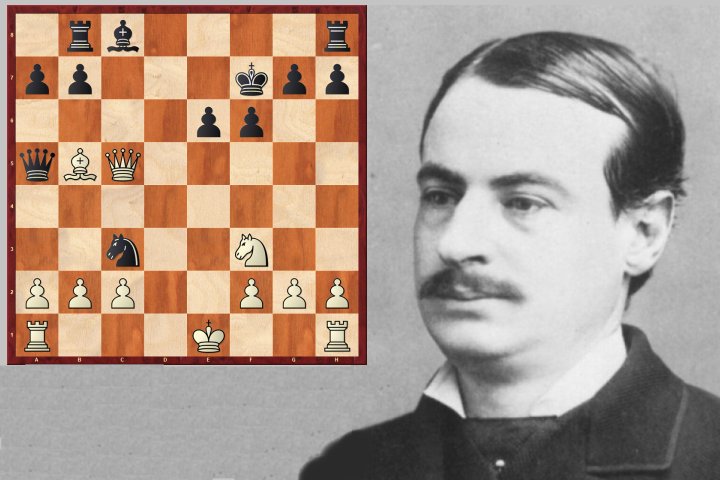James Mason and the invention of the London System
The more and more in-depth analysis of thousands of variations makes it increasingly difficult to achieve a tangible advantage at the beginning of a game, especially in the most frequently played openings. Many chess players therefore turn to less often used systems which are not so familiar to most of their opponents and which nevertheless offer enough potential to play for a win. In March 2018, for example, correspondence chess grandmaster Arno Nickel told me that he had recently used the London System successfully in several correspondence games. That makes you listen up, because especially in correspondence chess all means including computer support are allowed. What kind of opening is this "London System" that is increasingly being used successfully not only in correspondence chess, and which grandmaster was the first to take a closer look at it?
Henrik Danielsen used this system to win the Icelandic blitz championship in 2011. Some strong GMs and IMs didn't realise the danger before it was too late. Even after Black’s best defence, White will be able to fight for an advantage. After watching 60 minutes you have a total opening plan against 1...d5.
What is the London System?
In former times, the opening 1.d4 d5 2.Bf4 was simply called "Irregular Opening". It often results from a transposition of moves, e.g. after 1.d4 Nf6 2.Bf4 or 1.d4 d5 2.Nf3 Nf6 3.Bf4, etc. The 26th edition of the well known German "Chess Player's Textbook" by Jean Dufresne and Jacques Mieses in the new edition by IM Rudolf Teschner from 1975 shows how poorly this variation was treated only a few decades ago. Only one variation is actually mentioned there, and even this one ends after only 5 (!) moves:
Fortunately, more useful opening books are available these days. ChessBases for example offers some excellent DVDs which cover the London System in detail.
The first prominent proponent of the London System
The opening is now called the "London System" because it was applied several times in the London 1922 tournament. However, it had been been played much earlier. To get an overview, I consulted the MEGA Database of ChessBase to see all games played with this opening until the end of the 19th century. In fact, one name appeared more often than all the others: James Mason, the author of the well-known chess books "The Principles of Chess" and "The Art of Chess". From 1880 to 1894 he applied the London System with the white pieces in total (at least) 21 times in major tournaments. His score: 10:5 with 6 draws.
Who was James Mason?
"Harmoniously uniting in itself the curious, the beautiful, and the true, Chess appears to hold a permanent relation to the innate susceptibilities of intelligence." - James Mason ("The Principles of Chess", p. III)
James Mason was born on November, 19th, 1849 in the Irish town of Kilkenny and raised by adoptive parents. In 1861 they emigrated with him to the United States of America. Some years later he was already a decent chess player as we can learn from some of his games played in 1868.
At the age of 26 James Mason won the 4th US-American Chess Congress, which was held in Philadelphia from August, 17th, to August, 31st, 1876. He won eight games and lost only one with five draws. Thus he took 1st place in the double-round tournament with 10 1/2 out of 14 ahead of Max Judd (9) as well as Henry Edward Bird and Harry Davidson (8 1/2 each). In the same year Mason won another tournament in New York and a match against Henry Edward Bird (after whom the Bird opening 1.f4 is named). These successes brought the young US-American of Irish origin, who at that time was still working as a journalist for the "New York Herald", into the group of the best chess masters of that time.

James Mason
1877/78: James Mason at the top of the world rankings
The mathematician Jeff Sonas tried to calculate the historic Elo-ratings of the players of the past and the world rankings based on their tournament and match results (cf. www.chessmetrics.com). Surprisingly, James Mason was number 1 from August 1877 to June 1878! Here is an excerpt of the Elo-list list from August 1877:
- James Mason 2713
- Louis Paulsen 2678
- Amos Burn 2674
- Johannes Hermann Zukertort 2643
- Adolf Anderssen 2636
- Joseph Henry Blackburne 2621
- William Potter 2612
- Edward Alberoni 2607
- John Owen 2575
- George MacDonnell 2563
Mason's lead over the runner-up is 35 Elo-points. He is the only one of the top players of that time above the 2700 line.
To be fair, however, it should be added that Jeff Sonas removed players from his lists who had been inactive for a long time, i.e. did not participate in tournaments or matches. William Steinitz had still been number 1 in the list of July 1877 with a rating of 2752. One month later, however, his name is no longer listed. In August 1878, Johannes Hermann Zukertort took the top spot in the world rankings with a rating of 2743, while James Mason dropped back to number 8. Steinitz reappeared in the list of June 1882, on rank 3 - 4 and a rating of 2692 (tied with Mackenzie), but still behind Zukertort (2742) and Blackburne (2706). James Mason's best rating of 2715 dates from October 1876 and is in a comparable range.
At the time James Mason reached his highest historical Elo-rating, he was 26 years old. He thus belongs to the important group of chess players who reach their peak in their mid-20s. In this context, let us only think of Vladimir Kramnik from the year 2000! Even earlier was Mikhail Tal. He reached his highest historical Elo-rating (2799) at the age of 23, two months before his 24th birthday.
Chess professional in England
In 1878 James Mason moved to England and took part in several top-class international chess tournaments, e.g.
Berlin 1881 (2nd DSB Congress): Fifth with 9 1/2 out of 16 behind Blackburne (14), Zukertort (11), Winawer and Chigorin (10 1/2 each). In this tournament Mason was the only player who succeeded in defeating Blackburne. He also won against Chigorin and Louis Paulsen.
Vienna 1882: Third with 23 out of 34 behind Winawer and Steinitz (24 each) but ahead of J. H. Zukertort and Mackenzie (22 1/2 each). Blackburne followed with 21 1/2. 18 participants had been playing for 6 1/2 weeks, from Mai, 10th, to June, 24th.
Nuremberg 1883 (3rd DSB Congress): Third among 19 participants with 12 out of 18 behind Simon Winawer (14) and Joseph Henry Blackburne (13 1/2). Again he beat Blackburne and Louis Paulsen.
Hamburg 1885 (4th DSB Congress): Here James Mason shared 2nd prize with Blackburne, Englisch, Tarrasch and Weiss, only half a point behind Isidor Gunsberg (12 out of 17). Mason beat the winner of the tournament, Isidor Gunsberg, in their individual encounter. In the group of runners-up Mason won against Blackburne, but was defeated by 23-year-old Siegbert Tarrasch.
Mason's addiction to alcohol is rumoured to have affected his chess results in the following years. Accordingly, he performed worse at the German Chess Congresses, in which he still participated four more times:
At the 6th DSB Congress in Breslau 1889 Mason came in 8th-9th (tied with Blackburne). He scored 9 out of 17 which is still more than 50 %.
At the 7th DSB Congress in Dresden 1892 he again came in 8th-9th, this time with Hermann von Gottschall, and again achieved a plus score (9 out of 16).
At the 9th DSB Congress in Leipzig 1894, Mason was only 15th in a field of 18 players, and at his last participation, the 13th DSB Congress in Hannover 1902, he was the last-but-one.
How did James Mason play the London System?
Let's take a closer look at some of the games James Mason opened with the "London System". I selected a total of six winning games and commented on two of them. In three of these games we see the typical pawn structure d4, flanked by e3 and c3. In the other games James Mason sometimes played very unconventionally, e.g. Nc3, d4xc5 or even Bf4xNb8. Who would believe that with this exchange of his developed bishop for the inactive black knight he could defeat the world championship challenger Michail Chigorin in only 13 moves?
James Mason died on January, 15th, 1905, in Rochford (England). He was 55 years old. As well as his games he also left some remarkable books to the chess world. The best known are "The Principles of Chess" and "The Art of Chess". The didactic method used in them anticipates many things, which were only later deepened and elaborated by authors such as Lasker ("Manual of Chess"), Tarrasch ("The Game of Chess"), Nimzovich ("My System") and Znosko-Borovsky ("The Middle Game in Chess"). They represented a considerable progress compared to the textbooks of that time, because most of them consisted essentially of a conglomeration of innumerable opening variations, games with only brief annotations and the most important endgames.
There are two interesting articles dealing with James Mason by Edward Winter:
http://www.chesshistory.com/winter/winter137.html
http://www.chesshistory.com/winter/extra/alcohol.html
What is the trend in the London System? To play with or without Nf3? You can find the answers in the completely new powerbook - based on more than 187 000 games, most of them sourced in the engine room of playchess.
























